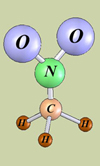Nitromethane - rocket fuel or what?
 A major factor in selecting any fuel for high-performance work is the ratio of the products of the reaction with the oxygen in the air to that of the reactants. In a liquid-fuelled space rocket, for instance, 1000 gallons of liquid oxygen will react with about 2000 of liquid hydrogen to create an exhaust gas many times the initial volume. This increase in volume escaping from beneath creates the thrust, which subsequently propels the projectile forward.
A major factor in selecting any fuel for high-performance work is the ratio of the products of the reaction with the oxygen in the air to that of the reactants. In a liquid-fuelled space rocket, for instance, 1000 gallons of liquid oxygen will react with about 2000 of liquid hydrogen to create an exhaust gas many times the initial volume. This increase in volume escaping from beneath creates the thrust, which subsequently propels the projectile forward.
Although experiments to use such fuels in reciprocating race engines have never met with much success, there is a 'rocket fuel' that has found favour in Top Fuel drag racing - nitromethane. With the chemical formula CH3NO2 it has some interesting properties.
The composition of hydrocarbon fuels means they burn only within a narrow range of air:fuel ratios (the ratios of air coming through the engine intake to the fuel consumed by mass for complete combustion). The oxygen required for combustion comes solely through the engine intake system, and therefore needs highly efficient engines with excellent volumetric efficiencies to achieve maximum power output. Nitromethane, however, already contains 52.5% of the oxygen needed for complete combustion, so the volume of oxygen in the air coming through the intake is arguably not quite so critical. Indeed, the more fuel that is supplied, the more oxygen that is imbibed and the more power is potentially available.
To put it into numbers, the stoichiometric air:fuel ratio is about 1.67:1; this compares with that of traditional hydrocarbon fuels that are somewhere nearer 14.7 :1. The downside with nitromethane though is that for every kilogramme burnt, only 11.3 MJ of heat is released; for most hydrocarbon fuels it is nearer 44 MJ. Nevertheless, if we can tip in up to nine times more fuel we can still generate more than twice the energy while burning the same amount of air. And with a heat of vaporisation of about twice that of the hydrocarbon fuel to create even denser air charges, it all begins to sound very encouraging. If we also take into account the faster flame speed of nitromethane, in theory requiring less ignition advance than other oxygenated fuels such as methanol, then nitromethane would seem to be the ideal fuel for motorsports.
It gets better. The real beauty of nitromethane is its ability to burn and therefore release its heat in the complete absence of air, so the emphasis on engine volumetric efficiency is arguably non-existent. However, when it burns, it forms a mixture of carbon dioxide, carbon monoxide, hydrogen, nitrogen and water - instead of just carbon dioxide and water - which can combine to form a mixture of nitrous/nitric acids, so the exhaust fumes are not only very unpleasant but poisonous too. So while the breathing of the engine may not be impaired, that of the driver most likely will be!
Also, because the fuel is so explosive - for want of a better word - it can only be used for short periods of time. In practical terms, high combustion temperatures of up to 2400 C limit its usefulness when lower compression ratios, rich mixtures and retarded ignition are necessary to counteract combustion knock.
Generally blended with methanol up to a maximum of 90%, nitromethane is therefore quite worthy of its name - 'rocket fuel'.
Fig. 1 -The nitromethane molecule
Written by John Coxon